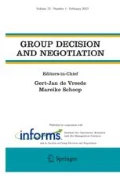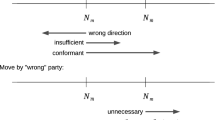Abstract
We analyze concession patterns in electronic negotiations using a modified version of the Actor–Partner Interdependence Model (APIM). Our extension of the APIM takes into account that concessions in negotiations can only be evaluated in terms of utilities of the receiving side. We show that actor and partner effects in that model can directly be related to central concepts of negotiation theory such as cooperative versus distributive bargaining tactics and reciprocity. Based on this connection, we formulate hypotheses on the differences of actor and partner effects between successful and failed negotiations. We test these hypotheses on two existing data sets. Results show consistent and strong actor effects, while partner effects are only present in specific settings.



Similar content being viewed by others
References
Adair W, Brett J (2005) The negotiation dance: time, culture, and behavioral sequences in negotiation. Organ Sci 16(1):33–51
Bazerman MH, Magliozzi T, Neale MA (1985) Integrative bargaining in a competitive market. Organ Behav Hum Decis Process 35:294–313
Benton AA, Kelley HH, Liebling B (1972) Effects of extremity of offers and concession rate on the outcomes of bargaining. J Personal Soc Psychol 24(1):73–83
Brett JM, Shapiro DL, Lytle AL (1998) Breaking the bonds of reciprocity in negotiations. Acad Manag J 41(4):410–424
Butt AN, Choi JN, Jaeger AM (2005) The effects of self-emotion, counterpart emotion, and counterpart behavior on negotiator behavior: a comparison of individual-level and dyad-level dynamics. J Organ Behav 26:681–704
Carbonneau R, Vahidov R (2012) Deriving concession curve patterns from human-to-agent negotiations. In: Almeida A (ed) Proceedings, Group decision and negotiation 2012, Recife, Brazil, pp 142–144
Carbonneau RA, Vahidov RM (2014) A utility concession curve data fitting model for quantitative analysis of negotiation styles. Expert Syst Appl 41(9):4035–4042
Carnevale PJ, Pruitt DG (1992) Negotiation and mediation. Ann Rev Psychol 43:531–582
Chertkoff JM, Conley M (1967) Opening offer and frequency of concession as bargaining strategies. J Personal Soc Psychol 7(2):181–185
Cialdini RB, Ascani K (1976) Test of a concession procedure for inducing verbal, behavioral, and further compliance with a request to give blood. J Appl Psychol 61(3):295–300
Cooper RB, Johnson NA (2014) So close yet no agreement: the effects of threats to self-esteem when using instant messaging and audio during seller–buyer negotiations. Decis Support Syst 57:115–126
Donohue WA, Taylor PJ (2007) Role effects in negotiation: the one-down phenomenon. Negot J 23(3):307–331
Druckman D, Mitterhofer R, Filzmoser M, Koeszegi S (2014) Resolving impasses in e-negotiation: does e-mediation work? Group Decis Negot 23(2):193–210
Falk A, Fischbacher U (2006) A theory of reciprocity. Games Econ Behav 54:293–315
Faratin P, Sierra C, Jennings NR (1998) Negotiation decision functions for autonomous agents. Robot Auton Syst 24:159–182
Faure GO (2011) Dumb barter: a seminal form of negotiation. Negot J 27(4):403–418
Fehr E, Gächter S (2000) Fairness and retaliation: the economics of reciprocity. J Econ Perspect 14(3): 159–181
Filzmoser M, Vetschera R (2008) A classification of bargaining steps and their impact on negotiation outcomes. Group Decis Negot 17:421–443
Gettinger JR, Dannenmann A, Druckman D, Filzmoser M, Mitterhofer R, Reiser A, Schoop M, Vetschera R, van der Wijst P, Koeszegi ST (2012) Impact of and interaction between behavioral and economic decision support in electronic negotiations. In: Hernández JE, Zaraté P, Dargam F, Delibašić B, Liu S, Ribeiro R (eds) Collaboration in real environments, Lecture notes in business information processing. Springer, London, pp 151–165
Gimpel H (2007) Preferences in negotiations—the attachment effect. Lecture notes in economics and mathematical systems. Springer, Berlin
Gouldner AW (1960) The norm of reciprocity: a preliminary statement. Am Sociol Rev 25(2):161–178
Hendon DW, Roy MH, Ahmed ZU (2003) Negotiation concession patterns: a multi-country, multiperiod study. Am Bus Rev 21(1):75–83
Hindriks K, Jonker CM, Tykhonov D (2007) Negotiation dynamics: analysis, concession tactics, and outcomes. In: Lin TYT, Bradshaw JM, Klusch M, Zhang C, Broder A, Ho H (eds) Proceedings of the 2007 IEEE/WIC/ACM international conference on intelligent agent technology, IEEE computer society, Washington, pp 427–433
Hinton BI, Hamner WC, Pohlen MF (1974) The influence of reward magnitude, opening bid and concession rate on profit earned in a managerial negotiation game. Behav Sci 19:197–203
Holmes ME (1992) Phase structures in negotiation. In: Putnam LL, Roloff ME (eds) Communication and negotiation. Sage, Newbury Park, pp 83–105
Johnson NA, Cooper RB (2009) Power and concession in computer-mediated negotiations: an examination of first offers. MIS Q 33(1):147–170
Kenny DA, Kashy DA, Cook WL (2006) Dyadic data analysis. The Guilford Press, New York
Kersten G, Noronha S (1999) WWW-based negotiation support: design, implementation, and use. Decis Support Syst 25(2):135–154
Kersten GE, Gimon D, Vahidov R (2012) Concession patterns in multi-issue negotiations and reverse auctions. In: Kauffman RJ (ed) International conference on electronic commerce, ICEC 2012, Singapore, pp 127–133
Kilmann RH, Thomas KW (1977) Developing a forced-choice measure of conflict-handling behavior: the “mode” instrument. Educ Psychol Meas 37(2):309–325
Koeszegi S, Vetschera R (2010) Analysis of negotiation processes. In: Kilgour DM, Eden C (eds) Handbook of group decision and negotiation. Springer, New York, pp 121–138
Koeszegi S, Srnka K, Pesendorfer EM (2006) Electronic negotiations: a comparison of different support systems. Die Betriebswirtschaft 66(4):441–463
Komorita SS, Brenner AR (1968) Bargaining and concession making under bilateral monopoly. J Personal Soc Psychol 9(1):15–20
Ludwig S (2008) Agent-based assistant for e-negotiations. In: An A, Matwin S, Ras ZW, Slczak D (eds) ISMIS’08 proceedings of the 17th international conference on foundations of intelligent systems. Springer, Berlin, pp 514–524
Ludwig SA, Kersten G, Huang X (2006) Towards a behavioral agent-based assistant for e-negotiations. Tech. Rep. INR 08/06, Interneg Research Center
Maxwell S, Nye P, Maxwell N (2003) The wrath of the fairness-primed negotiator when the reciprocity norm is violated. J Bus Res 56(5):399–409
Miller RL, Seligman C, Clark NT, Bush M (1976) Perceptual contrast versus reciprocal concession as mediators of induced compliance. Can J Behav Sci 8(4):401–409
Mintu-Wimsatt A, Calantone RJ (1996) Exploring factors that affect negotiators’ problem-solving orientation. J Bus Ind Mark 11(6):61–73
Mintu-Wimsatt A, Graham JL (2004) Testing a negotiation model on Canadian anglophone and Mexican exporters. J Acad Mark Sci 32(3):345–356
Mitterhofer R, Druckman D, Filzmoser M, Gettinger J, Schoop M, Koeszegi S (2012) Integration of behavioral and analytic decision support in electronic negotiations. In: Sprague RJ (ed) 45th annual Hawaii International conference on system sciences. IEEE Computer Society Press, Los Alamitos California, pp 610–617
Nastase V (2006) Concession curve analysis for Inspire negotiations. Group Decis Negot 15:185–193
Neale MA, Northcraft GB (1986) Experts, amateurs, and refrigerators: comparing expert and amateur negotiators in a novel task. Organ Behav Hum Decis Process 38:305–317
Olekalns M, Smith PL (2000) Understanding optimal outcomes: the role of strategy in competitive negotiations. Hum Commun Res 26(4):527–557
Parks CD, Komorita SS (1998) Reciprocity research and its implications for the negotiation process. Int Negot 3:151–169
Pinheiro J, Bates D, DebRoy S, Sarkar D, R Core Team (2013) NLME: linear and nonlinear mixed effects models. R package version 3.1-109
R Core Team (2014) R: a language and environment for statistical computing. R Foundation for Statistical Computing, Vienna, Austria. http://www.R-project.org/
Sanchez MH, Agoglia CP, Hatfield RC (2007) The effect of auditors’ use of a reciprocity-based strategy on auditor-client negotiations. Acc Rev 82(1):241–263
Schoop M, Amelsvoort M, Gettinger J, Koerner M, Koeszegi S, van der Wijst P (2014) The interplay of communication and decisions in electronic negotiations: communicative decisions or decisive communication? Group Decis Negot 23(2):167–192
Smith DL, Pruitt DG, Carnevale PJD (1982) Matching and mismatching: the effect of own limit, other’s toughness, and time pressure on concession rate in negotiation. J Personal Soc Psychol 42(5):876–883
Sokolova M, Szpakowicz S (2007) Strategies and language trends in learning success and failure of negotiation. Group Decis Negot 16:469–484
Stuhlmacher AF, Champagne MV (2000) The impact of time pressure and information on negotiation process and decisions. Group Decis Negot 9:471–491
Teich J, Wallenius H, Wallenius J (1994) Advances in negotiation science. Trans Oper Res 6:55–94
Turan N, Dai T, Sycara K, Weingart L (2009) Toward a unified negotiation framework: leveraging strengths in behavioral and computational communities. In: Proceedings of IJCAI 1999 workshop on modeling intercultural collaboration and negotiation, pp 94–111
Turel O (2010) Interdependence issues in analyzing negotiation data. Group Decis Negot 19:111–125
Tutzauer F (1992) The communication of offers in dyadic bargaining. In: Putnam L, Roloff ME (eds) Communication and negotiation. Sage, Newbury Park, pp 67–82
Tutzauer F (1993) Toughness in integrative bargaining. J Commun 43(1):46–62
Vetschera R (2007) Preference structures and negotiator behavior in electronic negotiations. Decis Support Syst 44(1):135–146
Vetschera R (2013) Negotiation processes: an integrated perspective. Eur J Decis Process 1(1–2):135–164
Vetschera R, Filzmoser M (2012) Standardized interpolated path analysis of offer processes in e-negotiations. In: Kauffman RJ (ed) International conference on electronic commerce ICEC 2012, Singapore, pp 134–140
Wall JA (1981) An investigation of reciprocity and reinforcement theories of bargaining behavior. Organ Behav Hum Perform 27:367–385
Weingart LR, Prietula MJ, Hyder EB, Genovese CR (1999) Knowledge and the sequential processes of negotiation: a Markov chain analysis of response-in-kind. J Exp Soc Psychol 35:366–393
Author information
Authors and Affiliations
Corresponding author
Additional information
I would like to thank Gregory Kersten for granting me access to the Inspire database, and Patrick Hippmann for many helpful discussions of the statistical analysis.
Rights and permissions
About this article
Cite this article
Vetschera, R. Concessions Dynamics in Electronic Negotiations: A Cross-Lagged Regression Analysis. Group Decis Negot 25, 245–265 (2016). https://doi.org/10.1007/s10726-015-9441-y
Published:
Issue Date:
DOI: https://doi.org/10.1007/s10726-015-9441-y




